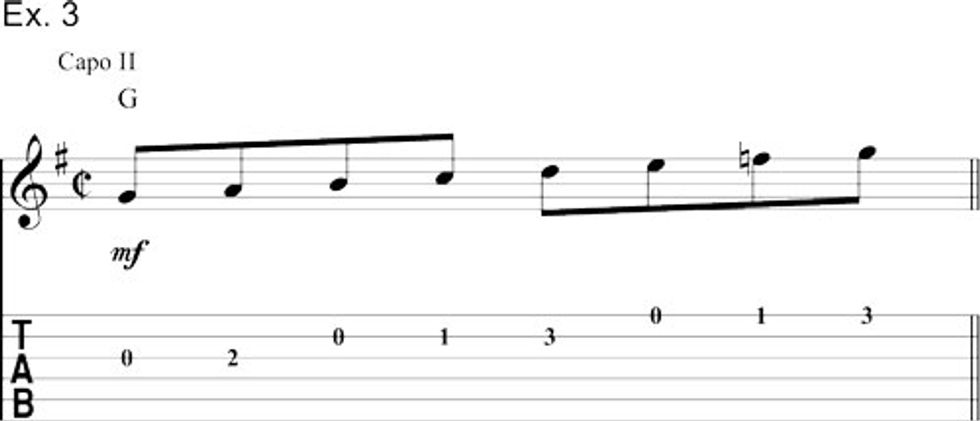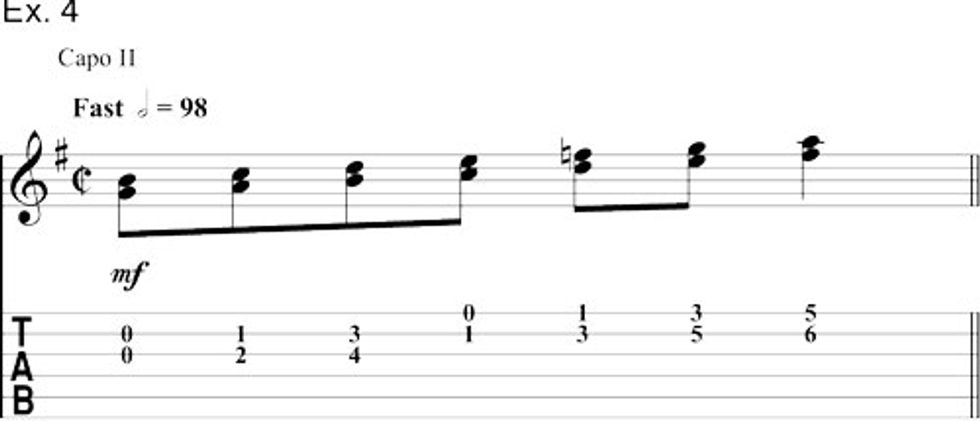Twelve golden nuances gleaned from flatpicking giants Norman Blake, Tony Rice, David Grier, and Bryan Sutton.
Chops: Intermediate
Theory: Beginner
Lesson Overview:
• Understand how to embellish traditional bluegrass melodies.
• Learn how to phrase with double-stop motifs.
• Strengthen your alternate-picking technique.
Click here to download a printable PDF of this lesson's notation.
We all have favorite guitarists who inspire us. One way to learn from these artists is to transcribe their playing, whether it’s a short lick or an entire solo. This process is a key part of developing and expanding our own vocabulary. In this lesson, I want to add another way to use reference recordings. Instead of an exact transcription of the material, try capturing the essence of what you are hearing and create your own take on the idea. This doesn’t replace note-for-note transcription, but rather it’s an additional strategy designed to expand your practice routine.
To demonstrate the concept, I’ve selected the classic bluegrass instrumental “Salt Creek.” Easy to pick up, this is a jam session favorite that provides ample material to mine for variation development. I’ll reference four YouTube videos that feature master flatpickers Norman Blake, Tony Rice, David Grier, and Bryan Sutton. Instead of a note-for-note breakdown, I’ll highlight a larger element or phrase that jumps out from the selected breaks, and then create something inspired by it. To avoid overwhelming you, I’ll only focus on the tune’s A section for development ideas.
What follows is a basic version of “Salt Creek” (Ex. 1). Even though we’ll focus on the A section for the lesson, here I’ve included the complete tune. That way, at a minimum, you leave the lesson with a version that will work for your next jam session. The common jam session key for this tune is A. However, all musical examples and analysis will be written in the key of G. So, capo at the 2nd fret, read the notation as presented, and you’ll be in A.
Click here for Ex. 1
Now that we have a basic version to work from, let’s dig into the reference recordings. Remember, we’re not necessarily looking for specific licks, but rather an element or phrase to inspire and send us on our way to create our own material based on the idea.
First up, Norman Blake and Tony Rice. The following video features Blake and Rice together.
There are several highlights that jump out while watching the clip. For me, Norman’s use of double-stops (two notes played together simultaneously) caught my attention as something I could play around with. Examples of this occur at approximately 0:29 seconds, 1:57, and 2:06.
Here’s a version of the A section (Ex. 2) using double-stops to present the melody.
Click here for Ex. 2
Though the chord progression is in the key of G, the inclusion of the F chord gives it a bluesy sound. The Mixolydian mode, which is nothing more than a major scale with a b7, captures that sound. In the key of G, that’s G–A–B–C–D–E–F (Ex. 3).
Harmonizing the scale in thirds will give us the double-stop material used in the above variation (Ex. 4).
Try crafting your own variation based off double-stops in thirds. You don’t have to push the idea through an entire A section. Instead, try applying the concept to a couple of measures here and there. In Ex. 5, I’ve used it in the third and fourth measures.
Click here for Ex. 5
Let’s examine Tony Rice’s breaks. A sound that stands out in this clip is the blues scale. Examples occur at approximately 1:25 and 1:32, and much of his second break, which starts around 2:10. Tony uses the G blues scale (G–Bb–C–Db–D–F) in the open and 3rd positions. Many of you are probably familiar with the following blues scale shapes (Ex. 6 and Ex. 7). If not, spend time getting comfortable with these before tackling the example.
Here’s a Rice-inspired break over the A section (Ex. 8) that includes fragments from both the open and 3rd position blues scale. Also, I’ve chosen to keep elements of the melody present while weaving in the blues scale material. I think it’s important to retain as much of the tune as possible and simply let the blues scale “flavor” the variation.
Click here for Ex. 8
Next up, David Grier. The following clip catches a solo guitar presentation of “Salt Creek.”
There’s a lot of wonderful stuff going on here. Something that stands out is how Grier often keeps multiple strings ringing simultaneously. Playing the melodic material out of chord shapes helps to achieve this ringing, flowing sound. Also, pick-hand accuracy is key to the execution of these ideas.
The following Grier-inspired, A-section excerpt (Ex. 9) begins by presenting the melody in the low register. When learning a tune, try to play its melody in multiple registers, and when possible, have a low, middle, and high version at your fingertips.
In measures 1 and 2, the melody is played out of the bottom string of a basic G chord. In measures 3 and 4, keep your fretting fingers in an F chord shape and only lift them out of the shape as needed. This will help to keep multiple notes ringing simultaneously. Pay special attention to the picking hand. I’ve played the example with strict alternate picking, where notes that fall on the beat get a downstroke and notes that fall between the count (the “and” part of the beat) are played with an upstroke.
Click here for Ex. 9
To wrap up this lesson, let’s shift our focus to Bryan Sutton. In the following clip, Bryan presents a blazing unaccompanied version of “Salt Creek.”
Don’t let this tempo intimidate you, there’s something here for any level player to pull out and use as an inspirational springboard. Let’s dig out an inspirational nugget now.
At 1:02 and 2:22 Bryan uses an open G-string drone against upper string melodic material. The following example (Ex. 10) presents a fragment of the G Mixolydian scale played with the drone on the 3rd string and melody notes on the 2nd string.
Click here for Ex. 10
The drone notes don’t always have to be articulated at the same time as the melody. In fact, alternating between the melody and drone can create a pleasing effect. When playing Ex. 11, keep the 3rd string ringing throughout and focus on strict alternate picking.
Click here for Ex. 11
Our final musical example (Ex. 12) puts the drone string concept to use in another version of the A section.
Click here for Ex. 12
I hope this lesson has given you some ideas on how to extrapolate concepts from recordings of artists who inspire you. Remember, this approach to interacting with recordings is not meant to replace the note-for-note transcription process. Rather, it’s a practice strategy that can help you assimilate ideas from these artists while cultivating licks you can call your own. Good luck and keep pickin’!







